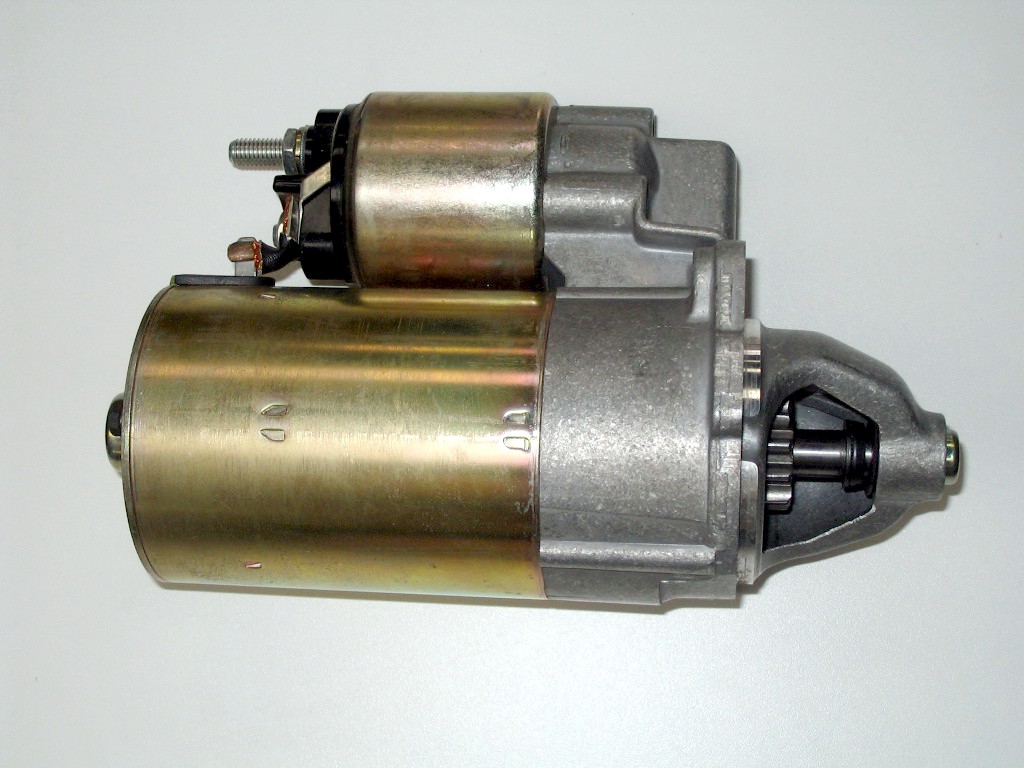Starter Solenoid on:
[Wikipedia]
[Google]
[Amazon]
A starter solenoid is an 
electromagnet
An electromagnet is a type of magnet in which the magnetic field is produced by an electric current. Electromagnets usually consist of wire wound into a coil. A current through the wire creates a magnetic field which is concentrated in the ...
which is actuated to engage the starter motor
A starter (also self-starter, cranking motor, or starter motor) is a device used to rotate (crank) an internal-combustion engine so as to initiate the engine's operation under its own power. Starters can be electric, pneumatic, or hydrauli ...
of an internal combustion engine
An internal combustion engine (ICE or IC engine) is a heat engine in which the combustion of a fuel occurs with an oxidizer (usually air) in a combustion chamber that is an integral part of the working fluid flow circuit. In an internal co ...
. It is normally attached directly to the starter motor which it controls.
Its primary function is as the actuating coil of a contactor
:''In semiconductor testing, contactors can also be referred to as the specialized socket that connects the device under test.''
:''In process industries, a contactor is a vessel where two streams interact, for example, air and liquid. See Gas ...
(a relay
A relay
Electromechanical relay schematic showing a control coil, four pairs of normally open and one pair of normally closed contacts
An automotive-style miniature relay with the dust cover taken off
A relay is an electrically operated swit ...
designed for large electric current
An electric current is a stream of charged particles, such as electrons or ions, moving through an electrical conductor or space. It is measured as the net rate of flow of electric charge through a surface or into a control volume. The movin ...
s) which connects the battery to the starter motor proper.
All modern cars also use the starter solenoid to move the starter pinion
A pinion is a round gear—usually the smaller of two meshed gears—used in several applications, including drivetrain and rack and pinion systems.
Applications
Drivetrain
Drivetrains usually feature a gear known as the pinion, which may ...
into engagement with the ring gear of the engine.
The starter solenoid is sometimes called the starter relay, but many cars reserve that name for a separate relay which supplies power to the starter solenoid. In these cases, the ignition switch
An ignition switch, starter switch or start switch is a switch in the control system of a motor vehicle that activates the main electrical systems for the vehicle, including "accessories" (radio, power windows, etc.). In vehicles powered by intern ...
energizes the starter relay, which energizes the starter solenoid, which energizes the starter motor.
Operation
An idle starter solenoid can receive a large electric current from the car battery and a small electric current from the ignition switch. When the ignition switch is turned on, a small electric current is sent through the starter solenoid. This causes the starter solenoid to close a pair of heavy contacts, thus relaying a large electric current through the starter motor, which in turn sets the engine in motion. The starter motor is a series, compound, or permanent magnet type electric motor with a solenoid and solenoid operated switch mounted on it. When low- current power from the starting battery is applied to the starter solenoid, usually through a key-operated switch, the solenoid closes high-current contacts for the starter motor and it starts to run. Once the engine starts, the key-operated switch is opened and the solenoid opens the contacts to the starter motor. All modern starters rely on the solenoid to engage the starter drive with the ring gear of the flywheel. When the solenoid is energized, it operates a plunger or lever which forces the pinion into mesh with the ring gear. The pinion incorporates a one way clutch so that when the engine starts and runs it will not attempt to drive the starter motor at excessive RPM. Some older starter designs, such as the Bendix drive, used the rotational inertia of the pinion to force it along a helical groove cut into the starter drive-shaft, and thus no mechanical linkage with the solenoid was required.Problems
If a starter solenoid receives insufficient power from the battery, it will fail to start the motor, and may produce a rapid clicking sound. The lack of power can be caused by a low battery, by corroded or loose connections in the battery cable, or by a damaged positive (red) cable from the battery. Any of these problems will result in some, but not enough, power being sent to the solenoid, which means that the solenoid will only begin to push the engagement gear, making the metallic click sound.References
{{Reflist Relays Vehicle parts